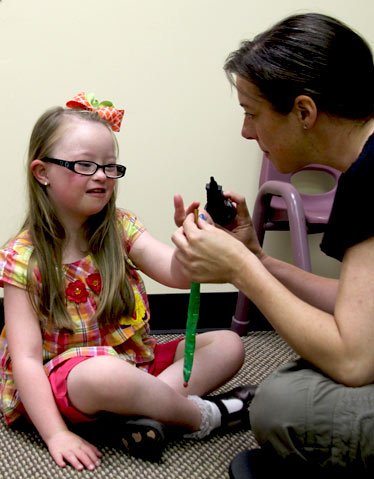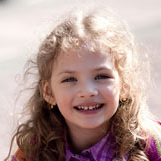
Sensory Processing Disorder (SPD) refers to challenges with the way in which a child experiences sensations of taste, touch, sound, sight, smell, movement and body awareness. Some children are highly sensitive to these sensations while others are under sensitive, and crave additional sensations. It is no surprise that children with SPD are often delayed in speech and/or language. If a child is distracted by discomfort caused by their environment, or if they are busy seeking sensations that are not readily available, they are less likely to be able to attend to speech and language learning opportunities. Children who are upset by the vibratory sensations that speech production elicits will often adapt by using speech sound substitutions or omissions. Children with SPD are often, also, seen by an Occupational Therapist who will focus on the global issues of SPD in addition to a Speech-Language Pathologist working on communication concerns.
Our sensory system is a "read and react" system. What this means we are "preprogrammed" to respond appropriately to environmental stimuli. This programming occurs throughout life and can be thought of as 'sensory learning' or processing.
The clearest example of this is a child placing their hand upon a hot stove… once it is done, it is rarely done again. This is because the burning and painful 'sensation' of the hot stove becomes ingrained in our memory, and helps prevent us from making this mistake again. All sensory patterns in the body work in this way.
The key elements to understand here are PERCEPTION and COORDINATION. Without proper perception, there cannot be proper (normal) coordination. Kids who suffer from SPD have an inability to properly perceive their environment, whether that be from vision, hearing and sounds, balance and coordination, touch and tactile sense, or others.
For children with SPD, this system "perception and coordination" system is essentially not "programmed" correctly. It becomes imbalanced and disorganized as the child develops, leading to improper neurological and brain development.
This can be caused by a variety of different things. The most common causes we encounter are traumatic birth injuries to the upper neck and brainstem regions (ie. forceps, vacuum extraction, C-section), childhood falls, and improper development through excessive use of infant car carriers, walkers, and jumpers.
What kids who suffer from things like SPD, ADD/ADHD, and ASD have in common, is that they have an inability to properly process, integrate, coordinate, and adapt to their sensory environment. All of these issues are really neurological INPUT and COORDINATION problems, not output and behavior problems.
The most common forms of treatment for these issues today are still focusing on modifying behavior, or output. But if we go back to that quote from Dr. Lipton, and really understand how the brain and nervous system work, it’s easy to understand that the only way to change and improve the output or behavior for these kids, is to change and improve their INPUT and ability to COORDINATE and ADAPT.

My husband and I are grateful to Cobblestone for everything they have done for our daughter Scarlett. We have had the pleasure of working with Lynn and it has been a life changing experience for our whole family. Scarlett has gained so much confidence in her abilities and we feel fortunate to have had this opportunity to work with them on her speech goals. We know that with their tools she will have a different level of learning than that of her peers. In addition, Jodie has been a delight to work with from getting us started to answering any questions we have in a timely manner. They treat you like part of the family and they truly care about your child.
Alana Kelly – 8 year-old daughter
We moved here last year and found Cobblestone to continue my then 4 year olds Apraxia therapy with Miss Samantha. Last week he had his last session. It’s been a wonderful year working with Samantha and Lynn and we are going to miss them so much. Samantha was a great therapist and worked so well with my son. Lynn is such a wonderful, kind, and caring woman and I truely enjoyed our afternoon chats. She runs her business so professionally, yet when you walk in the door, you feel like family. We had some issues with our insurance company and she worked so hard to get things fixed so that we didn’t have to deal with them ourselves.
Stacy Cote – 4 year-old son
We love Cobblestone! We have worked with several therapists over the past 3 years at Cobblestone. Each one has been easy to work with and adaptable to my sons needs. Due to Covid restrictions, we are seeing Kimberly remotely every week. I wasn't sure if remote therapy would be a great fit for my son, but she has made the transition extremely easy and engaging. He continues to work on and gain skills with every session. Kimberly is able to hold his attention for most of the session. Way to adapt Cobblestone! Thank you.
Jenn Grey –5 year-old son
First visit: Your first visit is an opportunity for the therapist, child and yourself to meet prior to an evaluation or intervention. You are welcome to bring siblings and other family members to this visit. The therapist will take this opportunity to informally observe your child's communication and play skills ... Learn more »
First visit: You will be coming to visit me soon at my office. When you arrive I will greet you and we will have some time to play and get to know each other. I will show you where the games and toys are and you will be able to pick out a couple that we can play with together ... Learn more »
7761 Shaffer Pkwy
Ste 140
Littleton, Colorado 80127
Phone: 303-952-9038
Fax: 720-622-9901